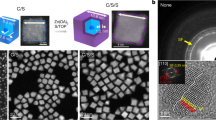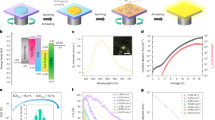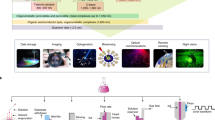Abstract
Organic light-emitting diodes (OLEDs) show promise for applications as high-quality self-emissive displays for portable devices such as cellular phones and personal organizers1,2,3,4. Although monochrome operation is sufficient for some applications, the extension to multi-colour devices—such as RGB (red, green, blue) matrix displays—could greatly enhance their technological impact. Multi-colour OLEDs have been successfully fabricated by vacuum deposition of small electroluminescent molecules, but solution processing of larger molecules (electroluminescent polymers) would result in a cheaper and simpler manufacturing process. However, it has proved difficult to combine the solution processing approach with the high-resolution patterning techniques required to produce a pixelated display. Recent attempts have focused on the modification of standard printing techniques, such as screen printing5,6,7 and ink jetting8, but those still have technical drawbacks. Here we report a class of electroluminescent polymers that can be patterned in a way similar to standard photoresist materials—soluble polymers with oxetane sidegroups that can be crosslinked photochemically to produce insoluble polymer networks in desired areas. The resolution of the process is sufficient to fabricate pixelated matrix displays. Consecutive deposition of polymers that are luminescent in each of the three RGB colours yielded a device with efficiencies comparable to state-of-the-art OLEDs and even slightly reduced onset voltages.
This is a preview of subscription content, access via your institution
Access options
Subscribe to this journal
Receive 51 print issues and online access
$199.00 per year
only $3.90 per issue
Buy this article
- Purchase on Springer Link
- Instant access to full article PDF
Prices may be subject to local taxes which are calculated during checkout



Similar content being viewed by others
References
Friend, R. H. et al. Electroluminescence in conjugated polymers. Nature 397, 121–128 (1999)
Heeger, A. J. Light emission from semiconducting polymers: light-emitting diodes, light-emitting electrochemical cells, lasers and white light for the future. Solid State Commun. 107, 673–679 (1998)
Kraft, A., Grimsdale, A. C. & Holmes, A. B. Angew. Chem. Int. Edn 37, 402–428 (1998)
Salbeck, J. Electroluminescence with organic compounds. Ber. Bunsenges. Phys. Chem. 100, 1667–1677 (1996)
Pardo, D. A., Jabbour, G. E. & Peyghambarian, N. Application of screen printing in the fabrication of organic light-emitting devices. Adv. Mater. 12, 1249–1252 (2000)
Birnstock, J. et al. Screen-printed passive matrix displays based on light-emitting polymers. Appl. Phys. Lett. 78, 3905–3907 (2001)
Birnstock, J. et al. Screen-printed passive matrix displays and multicolor devices. Proc. SPIE 4464, 68–73 (2001)
Haskal, E. et al. Ink jet printing of passive matrix polymer light-emitting displays. SID Digest Tech. Pap. 33, 776–779 (2002)
Seong, T. L. et al. A new patterning method for full-colour light-emitting diodes: laser-induced thermal imaging. SID Digest Tech. Pap. 33, 784–787 (2002)
Trattnig, C., Pogantsch, A., Langer, G., Kern, W. & Zojer, E. Polymer-based red, green and blue emitting devices fabricated by reductive photopatterning. Appl. Phys. Lett. 81, 4269–4271 (2002)
Müller, D. C. et al. Efficient blue organic light-emitting diodes with graded hole-transport layers. ChemPhysChem 1, 207–211 (2000)
Bayerl, M. S. et al. Cross-linkable hole transport materials—Preparation of multilayer organic light-emitting diodes by spincoating. Macromol. Rapid Commun. 20, 224–227 (1999)
Li, X. C. et al. A blue light emitting copolymer with charge transporting and photo-crosslinkable functional units. Synth. Met. 84, 437–438 (1997)
Le Barney, P., Bouche, C. M., Facoetti, H., Soyer, F. & Robin, P. Synthesis of side chain electroluminescent polymers and properties of devices including them. Proc. SPIE 3148, 160–169 (1997)
Bellmann, E. et al. New triarylamine-containing polymers as hole transport materials in organic light-emitting diodes: effect of polymer structure and crosslinking on device characteristics. Chem. Mater. 10, 1668–1676 (1998)
Jiang, X., Liu, S., Ma, H. & Jen, A. K. High-performance blue light-emitting diode based on a binaphthyl-containing polyfluorene. Appl. Phys. Lett. 76, 1813–1815 (2000)
Bacher, A. et al. Photo-cross-linked triphenylenes as novel insoluble hole transport materials in organic LEDs. Macromolecules 32, 4551–4557 (1999)
Li, W. et al. Covalently interlinked organic LED transport layers via spin-coating/siloxane condensation. Adv. Mater. 11, 730–734 (1999)
Chen, J. P. et al. Efficient, blue light-emitting diodes using cross-linked layers of polymeric arylamine and fluorene. Synth. Met. 107, 129–135 (1999)
Becker, H., Heun, S., Treacher, K., Büsing, A. & Falcou, A. Materials and inks for full-colour PLED displays. SID Digest Tech. Pap. 33, 780–782 (2002)
Fouassier, J-P. Photoinitiation, Photopolymerization, and Photocuring: Fundamentals and Applications 102–144 (Hanser/Gardner, Cincinnati, 1995)
Sasaki, H. & Crivello, J. V. The synthesis, characterization, and photoinitiated cationic polymerization of difunctional oxetanes. J. Macromol. Sci. A 29, 915–930 (1992)
Penczek, S. & Kubisa, P. in Comprehensive Polymer Science (ed. Allen, G.) Vol. III, 751–786 (Pergamon, Oxford, 1989)
Treacher, K. et al. Conjugated polymers containing spirobifluorene units and fluorene units, and the use thereof. German patent application DE 2001-10114477; WO 2002-077060.
Acknowledgements
Partial financial support was granted by the Deutsche Forschungsgemeinschaft, the Bundesministerium für Bildung und Forschung, the Fonds der Chemischen Industrie (Kekule grant for N.R.), and the Bavarian government through ‘Neue Werkstoffe’.
Author information
Authors and Affiliations
Corresponding author
Ethics declarations
Competing interests
The authors declare that they have no competing financial interests.
Rights and permissions
About this article
Cite this article
Müller, C., Falcou, A., Reckefuss, N. et al. Multi-colour organic light-emitting displays by solution processing. Nature 421, 829–833 (2003). https://doi.org/10.1038/nature01390
Received:
Accepted:
Issue Date:
DOI: https://doi.org/10.1038/nature01390
This article is cited by
-
Silicone engineered anisotropic lithography for ultrahigh-density OLEDs
Nature Communications (2022)
-
RGB WGM lasing woven in fiber braiding cavity
Science China Information Sciences (2022)
-
A novel benzo[4,5]furo[3,2-d]pyrimidine-based host as a n-type host for blue phosphorescent organic light-emitting diodes
Science China Materials (2022)
-
Organic conjugated polymers and polymer dots as photocatalysts for hydrogen production
Frontiers in Energy (2021)
-
Thin-film transistor-driven vertically stacked full-color organic light-emitting diodes for high-resolution active-matrix displays
Nature Communications (2020)
Comments
By submitting a comment you agree to abide by our Terms and Community Guidelines. If you find something abusive or that does not comply with our terms or guidelines please flag it as inappropriate.



